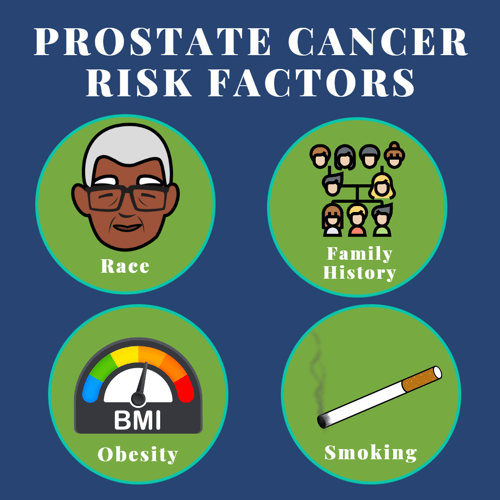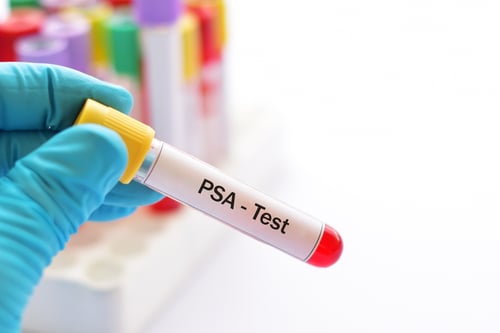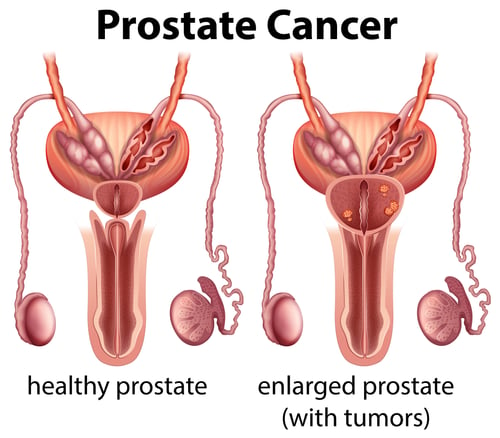Hearing the words “you have prostate cancer” from your doctor is sure to be a scary moment for anyone. Your brain is probably swimming with questions, as well as feelings of uncertainty. And if you are caring for a loved one with prostate cancer, you likely have just as many questions about things you want to better understand.
Taking the time to learn what this cancer is – and what is likely to happen during your prostate cancer treatment journey – can allow you to feel more prepared for what lies ahead.
Let’s get right to it. Here’s the most common questions that come up about prostate cancer:
What is prostate cancer?
This common form of cancer develops in the prostate gland. For men, prostate cancer is the second most common type of cancer, with only skin cancer occurring more frequently.

The prostate is part of the male reproductive system and this gland can be found near the bladder. Like other forms of cancer, prostate cancer develops when abnormal cells start to grow in an uncontrolled way.


What causes prostate cancer?
The exact cause of prostate cancer remains unknown. Cancer starts when cells in the body grow in an uncontrolled way. When prostate gland cells grow in this way, it’s called prostate cancer.
Fortunately, prostate cancers tend to grow very slowly. Successful treatment outcomes are very possible (especially when the cancer is detected early) with newer and more effective medications now available.
How to prevent prostate cancer?
One in nine American men are diagnosed with prostate cancer in their lifetime. However, this statistic can be misleading because risk is not spread evenly throughout a man’s lifespan. The risk for prostate cancer rises dramatically after age 50. Six out of 10 prostate cancers are in men over the age of 65.
Most of the things that increase your risk for prostate cancer are not things you can change. In addition to age increasing your risk, these are other factors that make prostate cancer more likely to develop:
Race: Prostate cancer is more common in Black men. In addition, Black men are twice as likely to die from the disease, as compared to White men. Prostate cancer, of all the forms of cancer, continues to have the widest racial disparity.
Family history: If you have a close relative with prostate cancer (such as a father, brother, or son), then you are at higher risk.
Obesity: A higher BMI (a measure of body fat) increases your risk of this disease.
Smoking is linked to prostate cancer. Quitting smoking lowers your chance of later developing prostate cancer.

Healthy diet and lifestyle choices that reduce overall risk of cancer are prudent; although no specific diet has been proven to lower one’s risk of prostate cancer.
Can women get prostate cancer?
The prostate is a walnut-shaped gland. It is located at the base of the bladder and is part of the male reproductive system.
Women cannot develop prostate cancer. This is because the prostate gland is only found in those born male. Although some trans women and non-binary people (if assigned male at birth) can develop prostate cancer.
Subscribe to the Prostate Cancer Blog
Get the latest news on prostate cancer in your email
How to test for prostate cancer?
The American Cancer Society recommends that a man discuss prostate cancer screening with his healthcare provider. This discussion should include information about both benefits and potential harms of treatment and it should occur at these ages:
Age 50: for men who are at average risk of prostate cancer and are expected to live at least 10 more years.
Age 45: for men at high risk of developing prostate cancer (i.e., Black men or any man with a close relative who had prostate cancer younger than age 65).
Age 40: for men at even higher risk (i.e., those with multiple relatives with an early-age prostate cancer). There are two main screening tests for prostate cancer: prostate-specific antigen (PSA) blood test and digital rectal exam. After one or both of these screening tests, some men will get a prostate biopsy to confirm if prostate cancer is present.
There are two main screening tests for prostate cancer: prostate-specific antigen (PSA) blood test and digital rectal exam. After one or both of these screening tests, some men will get a prostate biopsy to confirm if prostate cancer is present.
The PSA blood test checks for a type of protein associated with prostate cancer. This test cannot definitely determine whether or not cancer is present, but it is used to identify who might benefit from additional screening.

PSA levels can be higher than normal, even without prostate cancer being present, under certain conditions, including in those with a non-cancerous condition called benign prostatic hyperplasia (BPH), in older men, in those with prostatitis, after recent ejaculation, and with the use of certain medications.
After a prostate cancer diagnosis, the American Cancer Society offers guidance to navigate treatment decisions. The following factors should be considered in developing an appropriate treatment plan for you:
- The stage and grade of your cancer
- Age and expected life span
- Any other serious health conditions you may have
- Your feelings about the need to treat the cancer right away (since it is generally a slow-growing cancer)
- The likelihood that treatment will cure your cancer (or help in some other way)
- Your feelings about the possible side effects from each treatment
What are the 5 warning signs of prostate cancer?

There are often no signs or symptoms of prostate cancer, especially at first. But as the prostate cancer grows, one or more of the following signs may be noticed:
- Pain and/or a burning sensation when urinating
- Frequent urination, especially during the night
- Trouble starting urination, or difficulty stopping urination, once in progress
- Sudden erectile dysfunction
- Blood in either urine or semen
What are the 4 stages of prostate cancer?

Prostate cancer stages range from 1 through 4, with 1 being less serious and 4 being more serious.
Stage 1: The cancer is limited to just one side of the prostate gland, there is no lymph node involvement, and the PSA is low.
Stage 2: The cancer is only in the prostate gland.
Stage 3: The cancer is more progressed and is likely to spread to other parts of the body; the PSA score is high.
Stage 4: The cancer has already spread to lymph nodes or other areas of the body.
The vast majority (96%) of men diagnosed with prostate cancer are still alive five years after the diagnosis, especially those with a lower stage of cancer. In fact, prostate cancer is one of the more survivable cancers, especially at the lower stages. Most men who have had prostate cancer will not die from it. In fact, more than 3 million men in the United States who were diagnosed with this cancer are still alive today.

Sign up for Prostate Cancer updates
Get up-to-date information on managing your prostate cancer.
What are common prostate cancer drugs?
Here are some of the most common medications that your doctor might prescribe to treat prostate cancer:
- Abiraterone (generic for Zytiga)
- CASODEX® (bicalutamide)
- ELIGARD® (leuprolide)
- ERLEADATM (apalutamide)
- EULEXIN® (flutamide)
- LUPRON DEPOT® (leuprolide)
- NILANDRON® (nilutamide)
- TRELSTAR® (triptorelin)
- VANTAS® (histrelin)
- XTANDI ® (enzalutamide)
- YONSA® (abiraterone)
- ZOLADEX® (goserelin)

